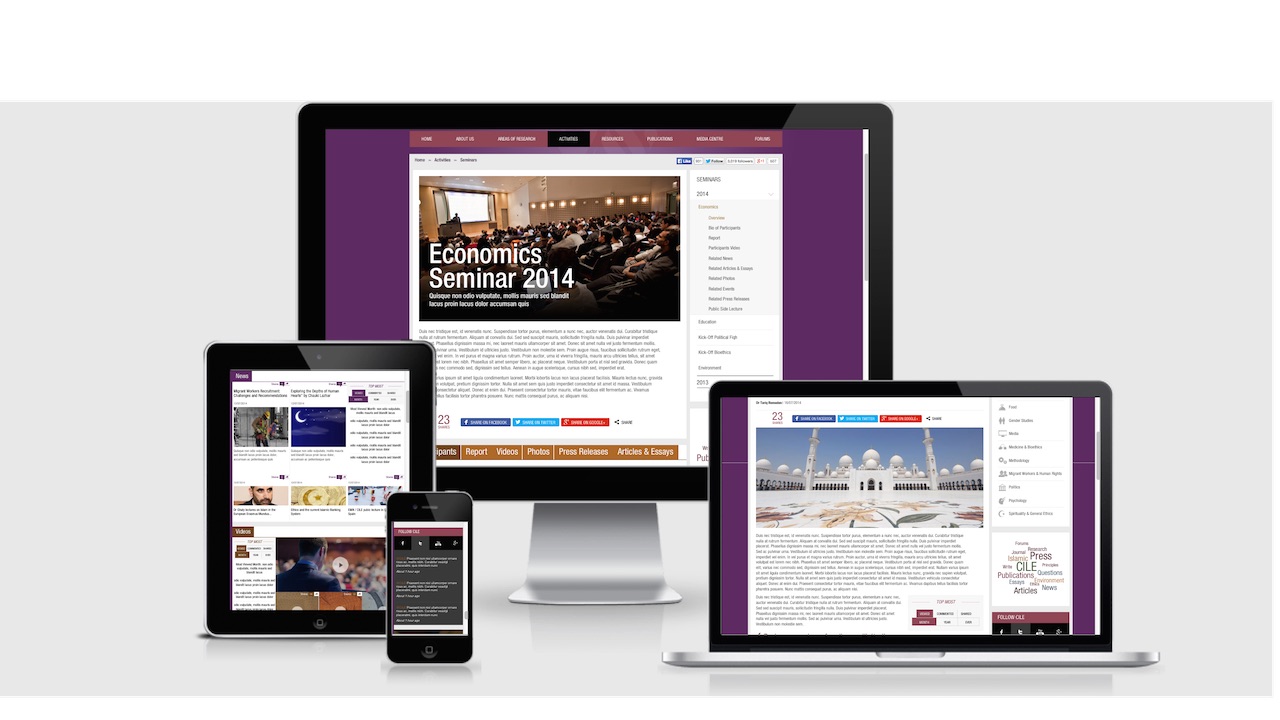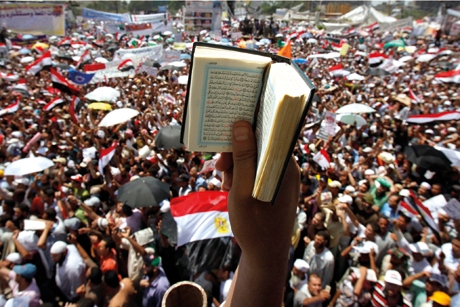For Muslims the Koran stands as the Text of reference, the source and the essence of the message transmitted to humanity by the creator. It is the last of a lengthy series of revelations addressed to humans down through history. It is the Word of God — but it is not God. The Koran makes known, reveals and guides: it is a light that responds to the quest for meaning. The Koran is remembrance of all previous messages, those of Noah and Abraham, of Moses and Jesus. Like them, it reminds and instructs our consciousness: life has meaning, facts are signs.
It is the Book of all Muslims the world over. But paradoxically, it is not the first book someone seeking to know Islam should read. (A life of the Prophet or any book presenting Islam would be a better introduction.) For it is both extremely simple and deeply complex. The nature of the spiritual, human, historical and social teachings to be drawn from it can be understood at different levels. The Text is one, but its readings are multiple.
For the woman or the man whose heart has made the message of Islam its own, the Koran speaks in a singular way. It is both the Voice and the Path. God speaks to one’s innermost being, to his consciousness, to his heart, and guides him onto the path that leads to knowledge of him, to the meeting with him: “This is the Book, about it there can be no doubt; it is a Path for those who are aware of God.” More than a mere text, it is a traveling companion to be chanted, to be sung or to be heard.
Throughout the Muslim world, in mosques, in homes and in the streets, one can hear magnificent voices reciting the divine Words. Here, there can be no distinction between religious scholars (ulema) and laymen. The Koran speaks to each in his language, accessibly, as if to match his intelligence, his heart, his questions, his joy as well as his pain. This is what the ulema have termed reading or listening as adoration. As Muslims read or hear the Text, they strive to suffuse themselves with the spiritual dimension of its message: beyond time, beyond history and the millions of beings who populate the earth, God is speaking to each of them, calling and reminding each of them, inviting, guiding, counseling and commanding. God responds, to her, to him, to the heart of each: with no intermediary, in the deepest intimacy.
No need for studies and diplomas, for masters and guides. Here, as we take our first steps, God beckons us with the simplicity of his closeness. The Koran belongs to everyone, free of distinction and of hierarchy. God responds to whoever comes to his Word. It is not rare to observe women and men, poor and rich, educated and illiterate, Eastern and Western, falling silent, staring into the distance, lost in thought, stepping back, weeping. The search for meaning has encountered the sacred, God is near: “Indeed, I am close at hand. I answer the call of him who calls me when s/he calls.”
A dialogue has begun. An intense, permanent, constantly renewed dialogue between a Book that speaks the infinite simplicity of the adoration of the One, and the heart that makes the intense effort necessary to liberate itself, to meet him. At the heart of every heart’s striving lies the Koran. It holds out peace and initiates into liberty.
Indeed, the Koran may be read at several levels, in quite distinct fields. But first, the reader must be aware of how the Text has been constructed. The Koran was revealed in sequences of varying length, sometimes as entire chapters (suras), over a span of 23 years. In its final form, the Text follows neither a chronological nor strictly thematic order. Two things initially strike the reader: the repetition of Prophetic stories, and the formulas and information that refer to specific historical situations that the Koran does not elucidate. Understanding, at this first level, calls for a twofold effort on the part of the reader: though repetition is, in a spiritual sense, a reminder and a revivification, in an intellectual sense it leads us to attempt to reconstruct. The stories of Eve and Adam, or of Moses, are repeated several times over with differing though noncontradictory elements: the task of human intelligence is to recompose the narrative structure, to bring together all the elements, allowing us to grasp the facts.
But we must also take into account the context to which these facts refer: all commentators, without distinction as to school of jurisprudence, agree that certain verses of the revealed Text (in particular, but not only, those that refer to war) speak of specific situations that had arisen at the moment of their revelation. Without taking historical contingency into account, it is impossible to obtain general information on this or that aspect of Islam. In such cases, our intelligence is invited to observe the facts, to study them in reference to a specific environment and to derive principles from them. It is a demanding task, which requires study, specialization and extreme caution. Or to put it differently, extreme intellectual modesty.
The second level is no less demanding. The Koranic text is, first and foremost, the promulgation of a message whose content has, above all, a moral dimension. On each page we behold the ethics, the underpinnings, the values and the hierarchy of Islam taking shape. In this light, a linear reading is likely to disorient the reader and to give rise to incoherence, even contradiction. It is appropriate, in our efforts to determine the moral message of Islam, to approach the Text from another angle. While the stories of the Prophets are drawn from repeated narrations, the study of ethical categories requires us, first, to approach the message in the broadest sense, then to derive the principles and values that make up the moral order. The methods to be applied at this second level are exactly the opposite of the first, but they complete it, making it possible for religious scholars to advance from the narration of a prophetic story to the codification of its spiritual and ethical teaching.
But there remains a third level, which demands full intellectual and spiritual immersion in the Text, and in the revealed message. Here, the task is to derive the Islamic prescriptions that govern matters of faith, of religious practice and of its fundamental precepts. In a broader sense, the task is to determine the laws and rules that will make it possible for all Muslims to have a frame of reference for the obligations, the prohibitions, the essential and secondary matters of religious practice, as well as those of the social sphere. A simple reading of the Koran does not suffice: not only is the study of Koranic science a necessity, but knowledge of segments of the prophetic tradition is essential. One cannot, on a simple reading of the Koran, learn how to pray. We must turn to authenticated prophetic tradition to determine the rules and the body movements of prayer.
As we can see, this third level requires singular knowledge and competence that can only be acquired by extensive, exhaustive study of the texts, their surrounding environment and, of course, intimate acquaintance with the classic and secular tradition of the Islamic sciences. It is not merely dangerous but fundamentally erroneous to generalize about what Muslims must and must not do based on a simple reading of the Koran. Some Muslims, taking a literalist or dogmatic approach, have become enmeshed in utterly false and unacceptable interpretations of the Koranic verses, which they possess neither the means, nor on occasion the intelligence, to place in the perspective of the overarching message. Some orientalists, sociologists and non-Muslim commentators follow their example by extracting from the Koran certain passages, which they then proceed to analyze in total disregard for the methodological tools employed by the ulema.
Above and beyond these distinct levels of reading, we must take into account the different interpretations put forward by the great Islamic classical tradition. It goes without saying that all Muslims consider the Koran to be the final divine revelation. But going back to the direct experience of the Companions of the Prophet, it has always been clear that the interpretation of its verses is plural in nature, and that there has always existed an accepted diversity of readings among Muslims.
Some have falsely claimed that because Muslims believe the Koran to be the word of God, interpretation and reform are impossible. This belief is then cited as the reason why a historical and critical approach cannot be applied to the revealed Text. The development of the sciences of the Koran — the methodological tools fashioned and wielded by the ulema and the history of Koranic commentary — prove such a conclusion baseless. Since the beginning, the three levels outlined above have led to a cautious approach to the texts, one that obligates whoever takes up the task to be in harmony with his era and to renew his comprehension. Dogmatic and often mummified, hidebound readings clearly reflect not upon the Author of the Text, but upon the intelligence and psychology of the person reading it. Just as we can read the work of a human author, from Marx to Keynes, in closed-minded and rigid fashion, we can approach divine revelation in a similar manner. Instead, we should be at once critical, open-minded and incisive. The history of Islamic civilization offers us ample proof of this.
When dealing with the Koran, it is neither appropriate nor helpful to draw lines of demarcation between approaches of the heart and of the mind. All the masters of Koranic studies without exception have emphasized the importance of the spiritual dimension as a necessary adjunct to the intellectual investigation of the meaning of the Koran. The heart possesses its own intelligence: “Have they not hearts with which to understand,” the Koran calls out to us, as if to point out that the light of intellect alone is not enough. The Muslim tradition, from the legal specialists to the Sufi mystics, has continuously oscillated between these two poles: the intelligence of the heart sheds the light by which the intelligence of the mind observes, perceives and derives meaning. As sacred word, the Text contains much that is apparent; it also contains the secrets and silences that nearness to the divine reveals to the humble, pious, contemplative intelligence. Reason opens the Book and reads it — but it does so in the company of the heart, of spirituality.
For the Muslim’s heart and conscience, the Koran is the mirror of the universe. What the first Western translators, influenced by the biblical vocabulary, rendered as “verse” means, literally, “sign” in Arabic. The revealed Book, the written Text, is made up of signs, in the same way that the universe, in the image of a text spread out before our eyes, abounds with these very signs. When the intelligence of the heart — and not analytical intelligence alone — reads the Koran and the world, the two speak to one another, echo one another; each one speaks of the other and of the Unique One. The signs remind us of meaning: of birth, of life, of feeling, of thought, of death.
But the echo is deeper still, and summons human intelligence to understand revelation, creation and their harmony. Just as the universe possesses its fundamental laws and its finely regulated order — which humans, wherever they may be, must respect when acting upon their environment — the Koran lays down laws, a moral code and a body of practice that Muslims must respect, whatever their era and their environment. These are the invariables of the universe, and of the Koran. Religious scholars use the term qat’i (“definitive,” “not subject to interpretation”) when they refer to the Koranic verses (or to the authenticated Prophetic tradition, ahadith) whose formulation is clear and explicit and offers no latitude for figurative interpretation. In like manner, creation itself rests upon universal laws that we cannot ignore. The consciousness of the believer likens the five pillars of Islam to the laws of gravitation: they constitute an earthly reality beyond space and time.
As the universe is in constant motion, rich in an infinite diversity of species, beings, civilizations, cultures and societies, so too is the Koran. In the latitude of interpretation offered by the majority of its verses, by the generality of the principles and actions that it promulgates with regard to social affairs, by the silences that run through it, the Koran allows human intelligence to grasp the evolution of history, the multiplicity of languages and cultures, and thus to insinuate itself into the windings of time and the landscapes of space.
Between the universe and the Koran, between these two realities, between these two texts, human intelligence must learn to distinguish fundamental and universal laws from circumstantial and historical models. This intelligence must display humility in the presence of the order, beauty and harmony of creation and of revelation. At the same time it must responsibly and creatively manage its own accomplishments or interpretations, which are sources of extraordinary success, but also of injustice, war and disorder. Between Text and context, the intelligence of the heart and that of the analytical faculty lay down norms, recognize an ethical structure, produce knowledge, nourish consciousness, and develop enterprise and creativity in all spheres of human activity.
Far from being a prison, or a constraint, revelation is an invitation to mankind to reconcile itself with its deepest essence, and to find there both the recognition of its limitations and the extraordinary potential of its intelligence and its imagination. To submit ourselves to the order of the Just One and of his eternity is to understand that we are free and fully authorized to reform the injustices that lie at the heart of the order or disorder of all that is temporally human.
The Koran is a book for both heart and mind. In nearness to it, a woman or a man who possesses a spark of faith knows the path to follow, knows her or his own inadequacies. No sheik is needed, no wise man, no confidant. Ultimately, the heart knows. This was what the Prophet answered when he was asked about moral feelings. In the light of the Book, he said, “Inquire of your heart.” And should our intelligence stray into the complexities of the different levels of reading, from applied ethics to the rules of practice, we must never forget to clothe ourselves in the intellectual modesty that alone can reveal the secrets of the Text. For “it is not the eyes that are blind, but the hearts within the breasts.” Such a heart, humble and alert, is the faithful friend of the Koran.
Tariq Ramadan is a professor of Islamic studies at Oxford and at Erasmus University in the Netherlands.
SOURCE : New York Times










Salam
une chose est clair, le commentaire du coran, manque, beaucoup à toute les générations, qui arrivent.
beucoup de débats, de conérences, de livres, sur bien souvent les même thèmes, mais le coran?
Et si il y a essouflement dans la oumma, c’est aussi parce que le coran, dans sa compréhension est délaisser.
Au-dela de la nouvelle mode, qu’est le tajwid, qui a remplacé l’obsession technique du halal et du haram, du technique, encore du technique…….
Allahou Alam
Wallahou mousta ane
Salam
I really enjoyed reading this article, you are so right. After years of being surrounded by people who take the dogmatic and literalist approach, your views are enlightening. You also have a wonderful way of explaining the most complex points and make your ideas accessible to all of us “The heart possesses its own intelligence”. Thank you…Shakkira xx